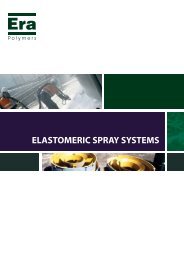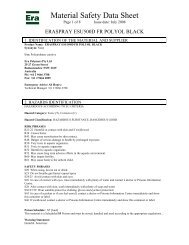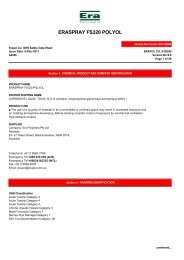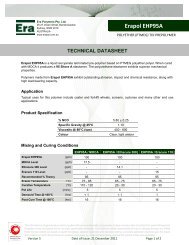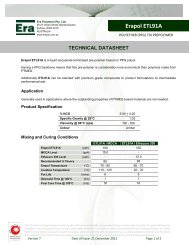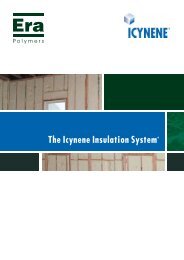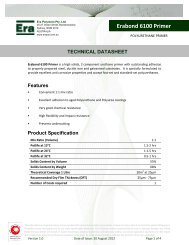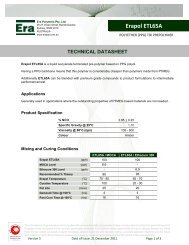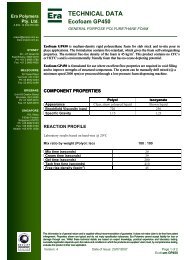Material Safety Data Sheet - Era Polymers
Material Safety Data Sheet - Era Polymers
Material Safety Data Sheet - Era Polymers
You also want an ePaper? Increase the reach of your titles
YUMPU automatically turns print PDFs into web optimized ePapers that Google loves.
<strong>Material</strong> <strong>Safety</strong> <strong>Data</strong> <strong>Sheet</strong>Page 5 of 7 Issue date: March 2007Futurathane 5041 IsocyanateProlonged or repeated skin contact may lead to dermatitis.Prolonged contact may cause severe eye irritation.Prolonged or repeated exposure may lead to irreversible damage to health.Prolonged or repeated contact with this substance will cause sensitisation by inhalation.Prolonged or repeated contact with this substance will cause sensitisation by skin contact.Toxicological <strong>Data</strong>:There is no other toxicological information available for this product.Toxicological <strong>Data</strong> for Ingredient(s):DIPHENYLMETHANE DIISOCYANATE [MDI]:Oral: LD50 (rat) > 5000 mg/kgDermal: LD50 (rabbit) > 2000 mg/kgInhalation: LC50 (4 hour, rat) = 490 mg/m3 (aerosol)Genetic toxicology: the assessment of all available data indicates that diphenylmethane diisocyanate has no significantmutagenic potential.Reproductive toxicology: there has been no observation of demonstration of adverse effects on reproduction due todiphenylmethane diisocyanate.12. ECOLOGICAL INFORMATIONEcotoxity:There is no information available for this product.Information for Ingredient(s):Diphenylmethane diisocyanate [MDI] generally shows low toxicity to a wide range of water and soil based species:bacteria, algae, invertebrates, fish, earthworms, plants and birds.Algae: EC50, 72 hour (Scenedesmus subspicatus, freshwater) = 1640 mg/LInvertebrates: EC50, 24 hour (Daphnia magna, freshwater) >= 500 mg/LFish: LC0, 96 hour (Brachydanio rerio, freshwater) >= 1000 mg/LMobility:The product is insoluble in water and does not disperse readily. It reacts with water forming polyurea, which is solid,insoluble and stable in the environment to both chemical and biological attack.Persistence / Degradability:This substance is not persistent in the environment as it reacts with water or moisture in the air. The reaction product,an inert, insoluble polyurea, is not readily degradable.Chemical Fate Information:There is limited ecological information available for this product, however, large quantities should not be dischargedinto drains, sewers or waterways.13. DISPOSAL CONSIDERATIONSDo not allow into any sewers, drains, on the ground or into any body of water. Any disposal must be in accordancewith applicable State, Territory and/or Local government regulations.Product Waste: The disposal of large quantities of product should normally be undertaken only by a specialistcontractor. The product may be incinerated in a suitable facility, however consult with local authorities before doing soto ensure that all local regulations are observed.In the case of only a small quantity of product waste, the following method may be applied, with caution, by atechnically competent person: The waste product is reacted with an excess of Polyol to form a foam or solidpolyurethane. The product of the reaction can then be incinerated or disposed of in landfill. This process should becarried out slowly in an open drum to avoid rapid heat generation and release of gases.Container Disposal: Any disposal of contaminated packaging and washings must be in accordance with State, Territoryand/or Local government regulations. When containers/drums have been drained to leave as little residue as possible,




